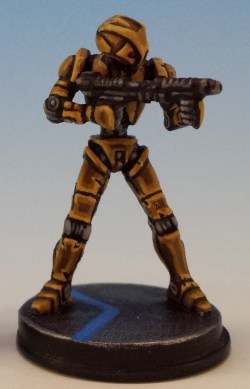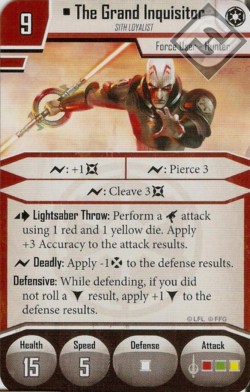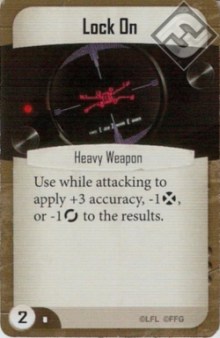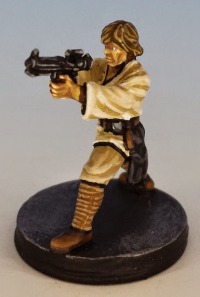Archive for the ‘Meta’ Category
The X-Files

HK Assassin Droid painted and photographed by Matthew of www.oldenhammer.com
Dodge?
It’s been a few weeks now since Jodocast.com released their article X-Happens. If you haven’t read it, stop now and read it before continuing here. This piece is a direct response to some of the thoughts and arguments brought forth by Joe.
Just to get you up to speed, in Imperial Assault the white die features one face with this cute little X symbol. As per rules, its effect is:
This result causes the entire attack to miss (the target suffers zero damage).
More specifically, a miss not only causes 0 damage, it also prevents the attacker from applying any conditions as result of this attack, wether they be positive or negative. So overall, this result effectively cancels the attack in its entirety. The origins of this mechanic are firmly rooted in the classic RPG game systems and most notable Dungeons & Dragons. Now the first question is … why? Why does this exist? Joe in his article already nails it:
One of the most amazing properties of the Dodge result in Imperial Assault is that out of everything in the game, it seems to be the source of the most extreme emotions felt by players on both ends of the spectrum. Nothing else in the game can quite make you feel the broad range of emotions as the Dodge.
The dodge result is in the game to make you feel something, good or bad. Increasing the emotions you feel when playing the game creates stronger and longer lasting memories, which is a good thing. Or is it?
All well in X-Land?
I don’t think it is. Or more precisely: I don’t think it’s good in skirmish. The thing about Imperial Assault is that it is split into a story driven part (the campaigns) and a very competitive part where you directly compete against other players. These 2 modes of play have pretty different goals of how they engage the players. Let’s look at the 2 parts more closely.
The campaign is typically played by 3-5 players. One of which is controlling the forces of the empire, while the others each play a rebel hero. In the core box alone, of the 19 imperial deployment cards only 5 have a white die for defense. That is of course including the mercenary cards. On the other hand, of the 6 rebel heroes, 3 of them and all 5 allies defend with a white die. It’s immediately apparent that the rebel faction has a wider selection of characters that use the white die, while the empire mostly has to resort to black dice for defense. This creates a theme where the empire is more sturdy and the rebels are more nimble. Also it tilts the “luck” in favor of the rebels creating moments where heroes survive just barely and creating long lasting memories. A match made in heaven.
The X-Factor
 However, in skirmish the story is different. There the gameplay is more symmetric with both players having access to the same tools and mechanics. Well not exactly. Players running rebel lists still have wider access to white defense dice both for trooper and signature units. Again, this a thematic home run, but does create some problems in actually resolving conflicts in skirmish. Where previously the majority of players benefited from that memory building flukes, now it’s only one of two players. More importantly, regardless if the dodge gets rolled or not, one of the players will feel exceptionally bad. Either the roll cancels a full attack, or the defender relies on the dodge to come up only to be disappointed.
However, in skirmish the story is different. There the gameplay is more symmetric with both players having access to the same tools and mechanics. Well not exactly. Players running rebel lists still have wider access to white defense dice both for trooper and signature units. Again, this a thematic home run, but does create some problems in actually resolving conflicts in skirmish. Where previously the majority of players benefited from that memory building flukes, now it’s only one of two players. More importantly, regardless if the dodge gets rolled or not, one of the players will feel exceptionally bad. Either the roll cancels a full attack, or the defender relies on the dodge to come up only to be disappointed.
This is bad for statistics. The dodge result is still very powerful but random rolls require that some games seem heavily tilted because of how often or seldom the result actually shows up. However, the really bad thing about it is that it takes away agency of the players. In competitive games, giving players ways to react or mitigate their opponents is creating exciting play experiences. Decisions are made. Combos happen. With the dodge result, this all goes away because of how all-encompassing its effect is. This is a bad way of making you feel something. There is nothing you can do about the dodge … or can you?
Redemption
 The developers of the game must have been caught on to this problem. There are a number of ways now to mitigate the effects of the dodge and most of them are indeed exclusive to skirmish or heavily geared towards it. It all started almost a year ago with the HK Assassin Droids. Their ability to re-roll dice cuts the likelyhood of a dodge result cancelling the attack from 1/6 to 1/36. Though … it didn’t really start with them. The core box already had the command card Lock On, which enables you to outright remove the dodge result. But especially since Return to Hoth, there has been a wealth of tools to get rid of that pesky little X.
The developers of the game must have been caught on to this problem. There are a number of ways now to mitigate the effects of the dodge and most of them are indeed exclusive to skirmish or heavily geared towards it. It all started almost a year ago with the HK Assassin Droids. Their ability to re-roll dice cuts the likelyhood of a dodge result cancelling the attack from 1/6 to 1/36. Though … it didn’t really start with them. The core box already had the command card Lock On, which enables you to outright remove the dodge result. But especially since Return to Hoth, there has been a wealth of tools to get rid of that pesky little X.
That cuts right into the next problem. There seems to be fragile agreement that the dodge needs to be downsized in skirmish. However, most recent tools focus on outright removing the result after all dice have been rerolled. The most recent example is the Grand Inquisitor. As long as he rolls a surge, the dodge result harms you more than it helps you. Granted, some figures come with an automatic evade which cancels one surge, but the Grand Inquisitor has a very high chance to roll 2 or even more surges anyway. This is just one example to illustrate that the white die is getting weakened to a degree where it is a liability.
It is the Future I see
Over time this would lead to the rebel faction being at a distinct disadvantage. Already bringing Rebel Troopers to skirmish seems like a fools errand. So how to solve this conundrum? Releasing fewer figures with a white die for defense? Issuing more tools to remove the result? I think both would be bad for the game. The best solution is probably one that the designers hesitate to consider. The effect of the dodge result should be fundamentally changed. While brainstorming during our meetup in Essen a few weeks ago I had some ideas. None of them will end up in the game, but they are fun to think about. The first is just changing the effect from outright cancelling the damage to just have it add 3 block and 1 evade to the results. But that is boring.
A much better idea would be to have it add 2 block and 1 evade and then have the defender reroll the die and add any results to the total. This would make the result much less of a feel bad event and more something you can still overcome. Figures with high damage potential still could reliably attack figures with white defense dice and get something done. It also would make the white die much more mechanically interesting as it now has a bigger potential to cancel surge results. And effects that would previously cancel the dodge result would just cancel the reroll.
What do YOU think about this? Are you certain this is just an imaginary problem? Do you also think there should be something done to the X-man? Let us know on twitter @BoardwarsEU or Facebook.
And thanks to the listeners hanging out on our discord server for the proof reading!
Allies, Strain and Side Mission Deck meta gaming
Having completed our 2nd campaign recently, I spoke to the other (Rebel) players about motivation and their general feelings throughout the campaign. One major thought was that the Subversive Tactics deck is not as fun to play against as it robs you of your awesome stuff. Also they were noticing a snowball effect which grew to be a bit distracting towards the end of the campaign. I have thoughts about that too, but today I want to write about their 3rd complaint: Allies and Ally Side Missions.

Luke painted and photographed by Matthew of www.oldenhammer.com
They managed to recruit Luke in their first campaign. But when learning about how taking him on a mission gives the Imperial Player additional Threat to work with, they sometimes were hesitant to bring him. Additionally, since you can only ever bring one Ally, they skipped all other Ally Missions for the remainder of the campaign.
For the 2nd campaign it was the other way around. After one red and one grey Side Mission, they were then swamped with green Side Missions until the end of the campaign. Even though they only played green Side Missions from then on, they didn’t win a single ally because of how strong Subversive Tactics is against Allies. They all were pretty disappointed in that they didn’t manage to get any special rewards for 3 of the 5 Side Missions as well as that they only got to chose from green Side Missions, knowing that they will be extra hard.
So I identified a few issues that I would try to tackle to improve player experience with the Side Mission Deck:
- Winning Allies should be easier if bringing Allies already buffs the starting Threat of the Imperial Player
- Each subsequent Ally Side Mission is worth less then the previous one.
- Player customization of the Side Mission Deck is very weak and feels too random.
- Increasing Rebel control over the Side Mission Deck calls for increased Imperial control over the Side Mission Deck
Also I didn’t want to upset the balance of the game too much, I just want to give the Rebel Players more control over their fate. I started with the issue of recruting Allies. To ensure the Rebels have a high chance of winning an Ally, I just award them automatically under the extended rules.
Mission Stage
Green Side Missions automatically award the respective Ally. If the Rebels win the Green Side Mission, they receive 1XP and 100 Credits per player and the Imperial player recieves 1XP and 1 Influence. If the Imperial Player wins the Green Side Mission the Rebels do not receive rewards (aside from Credits through crates collected) and the Imperial Player receives 1XP and 3 Influence.
I am unsure about the 3 Influence award if the Imperial Player wins the mission. 2 Influence might be enough. This is one for playtesting. Now this change makes green Side Missions much more rewarding for the Rebels right off the bat. If they lose the mission, they still get to keep the Ally. And if they win, they also get XP and credits. Still, if they get subsequent green Side Missions, they gain less than they lose, so I had to change how Side Missions are selected for the Side Mission Deck at the start of the campaign.
Campaign Setup
Heroes chose 2-4 green Side Mission cards to add to the Side Mission Deck.
This enables the Rebels to customize the Side Mission Deck much more. But this is only half of the story. Why not give the Rebels even more control over what side Missions are added to the Deck? So I arrived at this:
Campaign Setup
Changes to step 5):
Heroes chose 2-4 red Side Mission cards to add to the Side Mission Deck.
Heroes chose 2-4 green Side Mission cards to add to the Side Mission Deck.
Heroes chose a number between 2-7. Randomly add that amount of grey Side Mission cards to the Side Mission Deck.
This results in a final Side Mission Deck size of 6-15 cards.
Shuffle the Side Mission Deck.
The numbers for the grey Side Missions assume that the group has access to at least the Han Solo and Chewbacca Ally Packs. Though I feel this should work just as well without them if you reduce the maximum number of grey Side Missions. If the Rebel Players want, they can decrease their chance of encountering a green Side Mission significantly. They can also increase it. And this goes for all types of Side Missions. It’s hitting 2 birds with one stone. Still, if the Rebels can optimize which Side Missions come off the deck, they are in a better position to handle the missions. The Imperial Player needs some way to counteract that.
This brings me to the last major change I introduced with these extended rules. Since the Imperial Player has no way in the default rules to interact with the Side Mission Deck, I had to create one. What if we let him add Agenda and Forced Missions to the Side Mission deck after he bought them? He could dilute the Side Mission deck, but he would pay a steep price. So why not let the Imperial Player buy Agenda and Forced Missions at a discount and then shuffle them into the Side Mission Deck? He risks never seeing them again, but he also saved some Influence if he does. After a bit of tinkering I arrived at
Imperial Upgrade Stage
The Imperial Player can purchase Forced and Agenda Side Missions for 2 less Influence but at a minimum of 1 influence. If a Forced or Agenda Side Mission is purchased that way, put the Forced Mission into the Side Mission Deck and shuffle the Side Mission Deck.
Of course you need card sleeves that are intransparent on the back to make this works since Agenda and Forced Side Missions have a different card back than the regular Side Missions. And since we don’t want the Imperial Player to flood the Side Mission Deck we punish him for doing so
Mission Stage
If a Forced Mission or an Agenda Side Mission is drawn from the Side Mission Deck, immediately draw and reveal another Side Mission card until a regular Side Mission is drawn. Discard all but the first Forced/Agenda Mission. Forced Missions and Agenda Side Missions are resolved normally.
I expect this to create a much more dynamic struggle over the control of the Side Mission Deck. I also added a few more minor tweaks (mostly just changing up sequences) to fit with the new rules. You can read the full document here:
Houserules for the Imperial Assault: Core Box & Wave 1 Campaign on Google Drive
Let me know what you think about the changes and if there are some glaring issues I simply overlooked. I am currently working on a system to counteract the Snowball effect too, so expect another article about that soon.